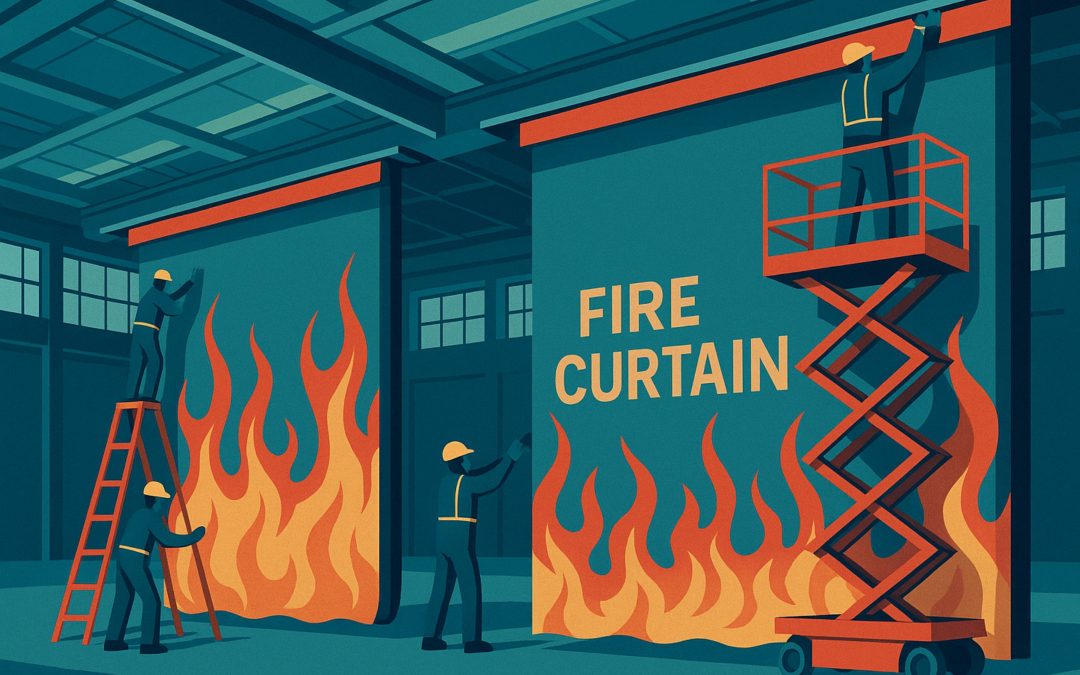Fire curtains are essential safety devices designed to contain and control fire in buildings. They play a key role in providing protection and enabling safe evacuation during a fire. Essentially, they are specially designed barriers that prevent the spread of flames, smoke, and toxic gases.
In their simplest form, a fire curtain is similar to a roller shutter but is much lighter. They are typically made from highly fire-resistant materials, such as woven fibreglass and stainless-steel fabric, often with an intumescent silicone coating. This material is wound around a roller and concealed within a top box. The edges of the fabric curtain are retained inside guides fixed to the opening, and a weighted bottom bar helps the curtain unwind and stabilise when deployed.
Why Use Fire Curtains? Purpose and Benefits
Fire curtains are primarily used to divide areas within a building to prevent the spread of fire and smoke. They are particularly valuable in large, open-plan areas like shopping centres, cinemas, theatres, airports, and offices, where traditional fire doors or walls may be impractical or undesirable due to architectural design preferences.
The primary purposes of fire curtains include:
- Limiting the development of fire.
- Preventing the spread of fire and toxic smoke.
- Protecting escape routes.
By compartmentalising a building space, fire curtains help to restrict oxygen and fuel, which can lower the intensity of a fire. This containment buys valuable time for emergency services and allows occupants more time to escape safely. Unlike traditional fire doors or shutters, fire curtains are often hidden out of sight until needed, preserving the aesthetic and spaciousness of the building. They are designed not to be seen and can be concealed above false ceilings or incorporated into structural elements and architectural finishes.
Fire curtains are innovative, space-efficient solutions that offer enhanced fire protection. Some advanced types can even reduce radiated heat flux, creating a tenable zone for passage. They can serve as a modern alternative to traditional fire doors, particularly where maintaining open corridors or doorways is essential.
How Fire Curtains Work: Operation and Activation
Fire curtains are a form of active fire protection, meaning they respond to the presence of fire. They are typically integrated into a building’s fire protection system and held in the open position daily. When triggered by a fire alarm system or local detectors, they automatically drop to their fire operational position, sealing off the space.
Fire curtains are typically installed per fire-tested documents, bolted or screw-fixed to the supporting construction. Technical support and installation manuals are usually provided to ensure a smooth process. Due to their compact size, they can be installed unobtrusively almost anywhere.
Maintaining the functionality and reliability of fire curtains is crucial. Regular servicing is recommended at least once a year, though some regulations suggest servicing powered doors every six months and routine testing (e.g., monthly). Service includes checking the curtain’s condition, testing its deployment mechanism, verifying compliance with standards, changing batteries in the control panel, and adjusting motor limits. A Service & Maintenance certificate is typically provided upon completion. It is important to note that maintenance is often offered only for systems installed by the specific company.
In the UK, compliance with fire safety regulations is mandatory. Building owners and employers are responsible for fire safety in non-domestic premises as the ‘responsible person’. They must carry out and regularly review a fire risk assessment. Fire curtains and other fire safety equipment must comply with regulations like England and Wales’s Regulatory Reform (Fire Safety) Order 2005. This fire safety order mandates that fire safety equipment, including fire doors and potentially fire curtains, must be subject to a suitable maintenance system and maintained efficiently.
Fire curtains are part of a broader passive system fire protection strategy. While fire curtains are active systems due to their deployment mechanism, they contribute to the passive principle of compartmentalisation, which aims to limit fire spread through physical barriers built into the structure. Other passive fire protection elements include cavity barriers, penetration sealing, fire doors, and fire-rated partitions.
TECL’s Installation at Ledston Hall, Pontefract
TECL is a contractor registered with quality accreditation bodies such as LPCB, ISO, and CHAS. It provides services related to fire stopping and passive fire protection. TECL completed fire stopping works on the Grade 1 listed building, Ledston Hall, in Pontefract.
As part of this project, TECL installed fire curtains. Specifically, the work included installing 30-minute and 60-minute fire curtains. This project demonstrates the application of fire curtain technology in heritage buildings, contributing to the overall fire safety strategy alongside other measures like Ablative Batt & Mastic for open penetrations.
In summary, fire curtains are a modern, discreet, and effective solution for controlling the spread of fire and smoke in buildings, particularly those with open-plan layouts. Their automatic deployment, fail-safe features, and ability to withstand fire for specified durations make them critical components of building fire protection. Compliance with UK standards and regulations, supported by third-party certification, is paramount to ensuring their reliability and effectiveness. TECL’s project at Ledston Hall exemplifies installing these vital safety devices in diverse building types, including historic properties, as part of a comprehensive fire safety approach.
